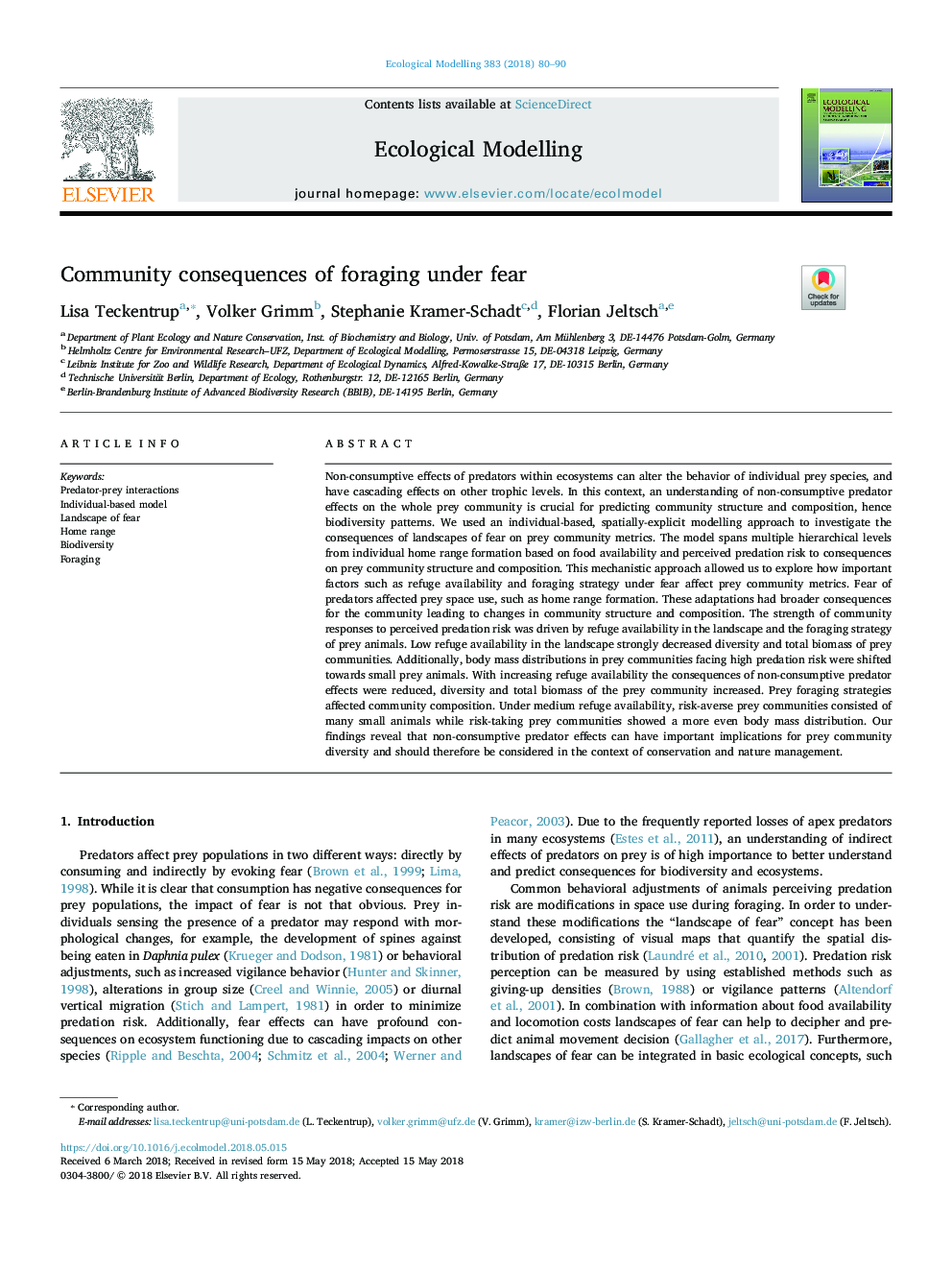| کد مقاله | کد نشریه | سال انتشار | مقاله انگلیسی | نسخه تمام متن |
|---|---|---|---|---|
| 8846001 | 1617364 | 2018 | 11 صفحه PDF | دانلود رایگان |
عنوان انگلیسی مقاله ISI
Community consequences of foraging under fear
ترجمه فارسی عنوان
عواقب اجتماعی خوردن تحت ترس
دانلود مقاله + سفارش ترجمه
دانلود مقاله ISI انگلیسی
رایگان برای ایرانیان
کلمات کلیدی
تعاملات شکارچی-طغیان، مدل مبتنی بر فرد چشم انداز ترس، محدوده خانه، تنوع زیستی، غذا خوردن،
ترجمه چکیده
اثرات غیر شفاف شکارچیان در اکوسیستم ها می تواند رفتار گونه های مختلف شکار را تغییر دهد و اثرات آبشار در دیگر سطوح طوفیک را نیز داشته باشد. در این زمینه، درک اثرات غافلگیرانه شکارچیان بر کل جوامع دریایی برای پیش بینی ساختار و ترکیب جامعه و از این رو الگوهای تنوع زیستی بسیار مهم است. ما از رویکرد مدل سازی مستقل مبتنی بر مکانی مناسبی برای بررسی پیامدهای مناظر ترس بر معیارهای شیطانی استفاده کردیم. این مدل، چندین سلسله مراتب را از مجموعه فردی خانه بر اساس دسترسی به مواد غذایی و خطر ابتلا به افسردگی در نظر گرفته تا عواقب آن بر ساختار و ترکیب جامعه حراست، می گذارد. این رویکرد مکانیستی به ما اجازه داد تا کشف کنیم که عوامل مهم مانند دسترسی به پناهگاه و استراتژی تغذیه تحت تأثیر ترس از معیارهای جامعه شیطانی چیست؟ ترس از شکارچیان از استفاده از فضای سحر استفاده کرد، مانند شکل گیری محدوده خانه. این سازگاری عواقب وسیعتری برای جامعه به دنبال تغییر در ساختار و ترکیب جامعه بود. استحکام پاسخ های جامعه به ریسک پیش بینی شده، از طریق دسترسی به پناهگاه در چشم انداز و استراتژی تغذیه حیوانات شکار هدایت شد. در دسترس بودن پناهگاه کم در چشم انداز، تنوع و مجموع زیست توده جوامع شکار را به شدت کاهش می دهد. علاوه بر این، توزیع توده بدنی در جوامع شیطانی که در معرض خطر بالای شکار قرار می گیرند نسبت به حیوانات کوچک طعمه تغییر یافته است. با افزایش در دسترس بودن پناهگاه، عواقب ناشی از اثرات شکارچیان کاهش یافت، تنوع و مجموع وزن زیست توده جوامع افزایش یافت. استراتژی های خوردن غذا بر ترکیب جامعه تاثیر می گذارد. در زمان دسترسی به پناهگاه های متوسط، جوامع شکار ریشوی مخالف شامل بسیاری از حیوانات کوچک بودند در حالیکه جوامع طعمه ای خطرناک توزیع توده بدن حتی بیشتر را نشان دادند. یافته های ما نشان می دهد که اثرات شکارچیان غیر مصرفی می تواند پیامدهای مهمی برای تنوع جوامع شکار داشته باشد و بنابراین باید در زمینه حفاظت و مدیریت طبیعت مورد توجه قرار گیرد.
موضوعات مرتبط
علوم زیستی و بیوفناوری
علوم کشاورزی و بیولوژیک
بوم شناسی، تکامل، رفتار و سامانه شناسی
چکیده انگلیسی
Non-consumptive effects of predators within ecosystems can alter the behavior of individual prey species, and have cascading effects on other trophic levels. In this context, an understanding of non-consumptive predator effects on the whole prey community is crucial for predicting community structure and composition, hence biodiversity patterns. We used an individual-based, spatially-explicit modelling approach to investigate the consequences of landscapes of fear on prey community metrics. The model spans multiple hierarchical levels from individual home range formation based on food availability and perceived predation risk to consequences on prey community structure and composition. This mechanistic approach allowed us to explore how important factors such as refuge availability and foraging strategy under fear affect prey community metrics. Fear of predators affected prey space use, such as home range formation. These adaptations had broader consequences for the community leading to changes in community structure and composition. The strength of community responses to perceived predation risk was driven by refuge availability in the landscape and the foraging strategy of prey animals. Low refuge availability in the landscape strongly decreased diversity and total biomass of prey communities. Additionally, body mass distributions in prey communities facing high predation risk were shifted towards small prey animals. With increasing refuge availability the consequences of non-consumptive predator effects were reduced, diversity and total biomass of the prey community increased. Prey foraging strategies affected community composition. Under medium refuge availability, risk-averse prey communities consisted of many small animals while risk-taking prey communities showed a more even body mass distribution. Our findings reveal that non-consumptive predator effects can have important implications for prey community diversity and should therefore be considered in the context of conservation and nature management.
ناشر
Database: Elsevier - ScienceDirect (ساینس دایرکت)
Journal: Ecological Modelling - Volume 383, 10 September 2018, Pages 80-90
Journal: Ecological Modelling - Volume 383, 10 September 2018, Pages 80-90
نویسندگان
Lisa Teckentrup, Volker Grimm, Stephanie Kramer-Schadt, Florian Jeltsch,
